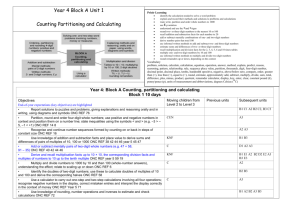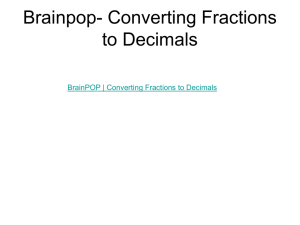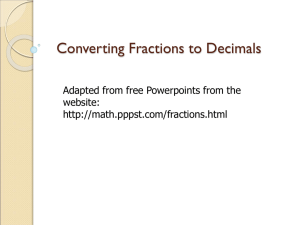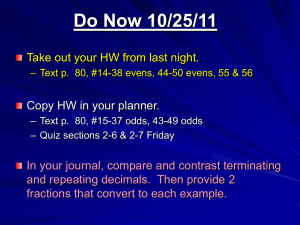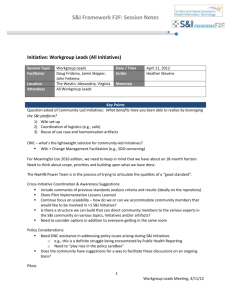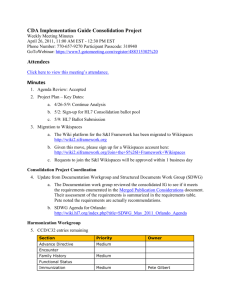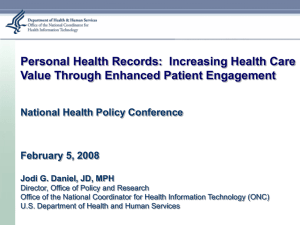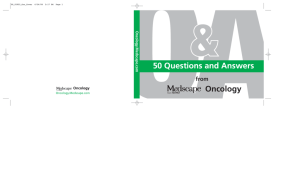Year Five
advertisement
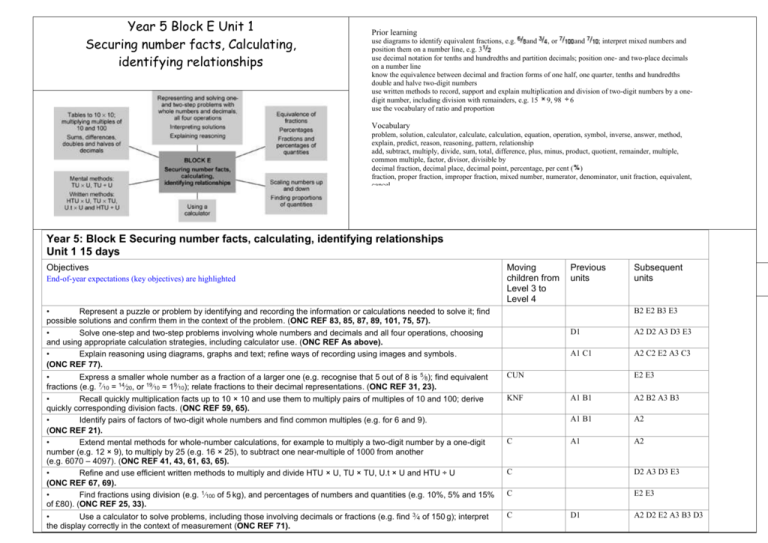
Year 5 Block E Unit 1 Securing number facts, Calculating, identifying relationships Prior learning use diagrams to identify equivalent fractions, e.g. and , or and ; interpret mixed numbers and position them on a number line, e.g. 3 use decimal notation for tenths and hundredths and partition decimals; position one- and two-place decimals on a number line know the equivalence between decimal and fraction forms of one half, one quarter, tenths and hundredths double and halve two-digit numbers use written methods to record, support and explain multiplication and division of two-digit numbers by a onedigit number, including division with remainders, e.g. 15 9, 98 6 use the vocabulary of ratio and proportion Vocabulary problem, solution, calculator, calculate, calculation, equation, operation, symbol, inverse, answer, method, explain, predict, reason, reasoning, pattern, relationship add, subtract, multiply, divide, sum, total, difference, plus, minus, product, quotient, remainder, multiple, common multiple, factor, divisor, divisible by decimal fraction, decimal place, decimal point, percentage, per cent ( ) fraction, proper fraction, improper fraction, mixed number, numerator, denominator, unit fraction, equivalent, cancel Year 5: Block E Securing number facts, calculating, identifying relationships Unit 1 15 days Objectives End-of-year expectations (key objectives) are highlighted Moving children from Level 3 to Level 4 • Represent a puzzle or problem by identifying and recording the information or calculations needed to solve it; find possible solutions and confirm them in the context of the problem. (ONC REF 83, 85, 87, 89, 101, 75, 57). • Solve one-step and two-step problems involving whole numbers and decimals and all four operations, choosing and using appropriate calculation strategies, including calculator use. (ONC REF As above). • Explain reasoning using diagrams, graphs and text; refine ways of recording using images and symbols. (ONC REF 77). Previous units Subsequent units B2 E2 B3 E3 • Express a smaller whole number as a fraction of a larger one (e.g. recognise that 5 out of 8 is 58); find equivalent fractions (e.g. 710 = 1420, or 1910 = 1910); relate fractions to their decimal representations. (ONC REF 31, 23). • Recall quickly multiplication facts up to 10 × 10 and use them to multiply pairs of multiples of 10 and 100; derive quickly corresponding division facts. (ONC REF 59, 65). • Identify pairs of factors of two-digit whole numbers and find common multiples (e.g. for 6 and 9). (ONC REF 21). • Extend mental methods for whole-number calculations, for example to multiply a two-digit number by a one-digit number (e.g. 12 × 9), to multiply by 25 (e.g. 16 × 25), to subtract one near-multiple of 1000 from another (e.g. 6070 – 4097). (ONC REF 41, 43, 61, 63, 65). • Refine and use efficient written methods to multiply and divide HTU × U, TU × TU, U.t × U and HTU ÷ U (ONC REF 67, 69). • Find fractions using division (e.g. 1100 of 5 kg), and percentages of numbers and quantities (e.g. 10%, 5% and 15% of £80). (ONC REF 25, 33). CUN • Use a calculator to solve problems, including those involving decimals or fractions (e.g. find 34 of 150 g); interpret the display correctly in the context of measurement (ONC REF 71). C KNF C D1 A2 D2 A3 D3 E3 A1 C1 A2 C2 E2 A3 C3 E2 E3 A1 B1 A2 B2 A3 B3 A1 B1 A2 A1 A2 C D2 A3 D3 E3 C E2 E3 D1 A2 D2 E2 A3 B3 D3
